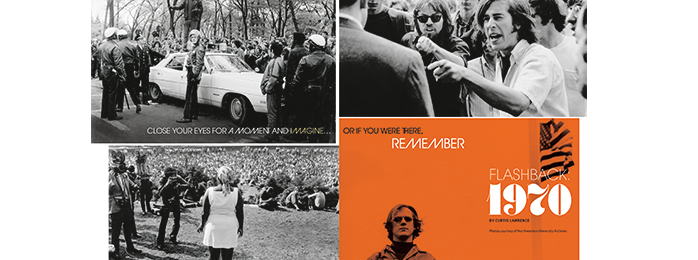
Back Talk
The Weinberg magazine article “Flashback: 1970” (Spring/Summer 2015) reflected on the tumultuous protest era at Northwestern, including the student strike in 1970 and the Black Student Sit-In in 1968. The stories inspired a number of readers to share their reflections on that period. Here are a few of their comments.
I want to add to the history.
Eleven of us at Northwestern University tried to create a “peace train” to travel around the northeastern part of the United States to explain to the public why the war effort needed to stop. That time forever changed my life and my views about social justice. It formed my views about the role and responsibility of government to help the less fortunate individuals in our society. It demonstrated how a small but committed group of people could make a real difference — we did shut down the school, even if we didn’t get the peace train.
I am looking at the original grant right now. It is titled “Peace Train 1970: An attempt to couple the idealism and enthusiasm of youth with the wisdom and experience of age to end the war in Vietnam.” The proposal required us to raise $702,000.
We were so idealistic (and unrealistic) that we actually thought it would happen. We tried to raise the money… not successfully…but it was an amazing time.
Here are the names listed on the grant application: Eva Jefferson ’71, Don Bush, graduate student, Vincent Fish ’72, Alan Fishman, graduate student, Harold Helgeson, associate professor of geological sciences, Neal Kaufman ’71, Sue Greenberg ’71, Harriet Mintzer ’73, Dave Conant ’72, Richard Hollander, DePaul University College of Law ’73, and Clarence Ver Steeg, professor of history.
Would love to connect with anyone who remembers this effort.
— Neal Kaufman ’71, M.D., M.P.H.
Adjunct Professor of Pediatrics and Public Health
Chief Medical Officer, Canary Health
Los Angeles, Calif.
I was disappointed by your article “Flashback: 1970” in the Spring/Summer 2015 issue of Weinberg magazine. The article was a one-sided accolade of a serious and controversial event. The writer gives a lengthy review of Mr. [Jeff] Rice’s satisfaction over the achievements of the protest (this section of the article even receives the thumbs-up subtitle “Pushed to the Edge”), and Ms. Paterson’s happy conversion to the cause. Missing, however, is any discussion about the darker side of the event — and indeed the era.
A group of citizens destroyed property with impunity. The armed forces of our country were demeaned and dishonored — armed forces comprised mostly of young men from less fortunate backgrounds than those of the protestors. The broader movement promoted a sense of normality around the use of drugs, the results of which still plague our nation today.
Our elite universities have earned a reputation for one-sided political thinking. Whether that is right or wrong, articles like this promote that impression.
— John N. Colis ’79; Kellogg MBA ’83
Glenview, Ill.
After the Kent State incident, academics on campus stopped. The fences along Sheridan Road were pulled up and bonfires erupted in the street. All night, political and activist discussions took place. Classes, indeed the semester, were cancelled. We donned armbands that read “Stop the Killing” and went into the neighborhood shopping centers. It was odd. The merchants welcomed us, but the ordinary shoppers screamed at us like we were terrorists. Of course, the merchants wanted no riots, and the “ordinary shoppers” perhaps had relatives fighting in Vietnam. Many of us faced the draft, and I had two physical exams, which I passed; but luckily the lottery came in before I was drafted and my draft board went through the number 198. My number was 205. Still, many of my colleagues had lower numbers and had to decide whether to leave (most for Canada) or enlist, or simply wait to get drafted. The names of some of my high school classmates are engraved on the memorial in Washington, D.C. It was a sobering time
— Bruce Harmon, Ph.D. ’73
Distinguished Professor Emeritus, Iowa State University
Ames, Iowa